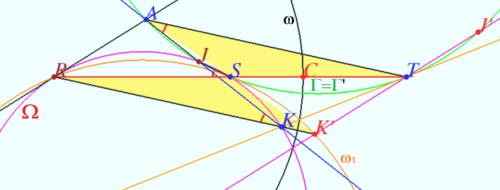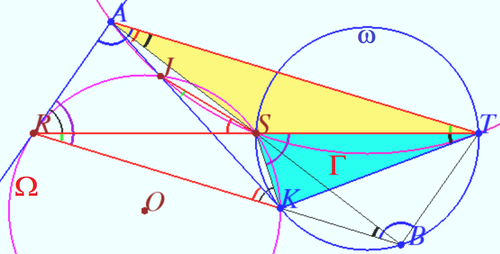Difference between revisions of "2017 IMO Problems/Problem 4"
(→Solution) |
|||
| (16 intermediate revisions by 2 users not shown) | |||
| Line 1: | Line 1: | ||
| + | ==Problem== | ||
| + | |||
Let <math>R</math> and <math>S</math> be different points on a circle <math>\Omega</math> such that <math>RS</math> is not a diameter. Let <math>\ell</math> be the tangent line to <math>\Omega</math> at <math>R</math>. Point <math>T</math> is such that <math>S</math> is the midpoint of the line segment <math>RT</math>. Point <math>J</math> is chosen on the shorter arc <math>RS</math> of <math>\Omega</math> so that the circumcircle <math>\Gamma</math> of triangle <math>JST</math> intersects <math>\ell</math> at two distinct points. Let <math>A</math> be the common point of <math>\Gamma</math> and <math>\ell</math> that is closer to <math>R</math>. Line <math>AJ</math> meets <math>\Omega</math> again at <math>K</math>. Prove that the line <math>KT</math> is tangent to <math>\Gamma</math>. | Let <math>R</math> and <math>S</math> be different points on a circle <math>\Omega</math> such that <math>RS</math> is not a diameter. Let <math>\ell</math> be the tangent line to <math>\Omega</math> at <math>R</math>. Point <math>T</math> is such that <math>S</math> is the midpoint of the line segment <math>RT</math>. Point <math>J</math> is chosen on the shorter arc <math>RS</math> of <math>\Omega</math> so that the circumcircle <math>\Gamma</math> of triangle <math>JST</math> intersects <math>\ell</math> at two distinct points. Let <math>A</math> be the common point of <math>\Gamma</math> and <math>\ell</math> that is closer to <math>R</math>. Line <math>AJ</math> meets <math>\Omega</math> again at <math>K</math>. Prove that the line <math>KT</math> is tangent to <math>\Gamma</math>. | ||
| Line 5: | Line 7: | ||
We construct inversion which maps <math>KT</math> into the circle <math>\omega_1</math> and <math>\Gamma</math> into <math>\Gamma.</math> Than we prove that <math>\omega_1</math> is tangent to <math>\Gamma.</math> | We construct inversion which maps <math>KT</math> into the circle <math>\omega_1</math> and <math>\Gamma</math> into <math>\Gamma.</math> Than we prove that <math>\omega_1</math> is tangent to <math>\Gamma.</math> | ||
| − | + | Quadrangle <math>RJSK</math> is cyclic <math>\implies \angle RSJ = \angle RKJ.</math> | |
| − | + | ||
| + | Quadrangle <math>AJST</math> is cyclic <math>\implies \angle RSJ = \angle TAJ \implies AT||RK.</math> | ||
We construct circle <math>\omega</math> centered at <math>R</math> which maps <math>\Gamma</math> into <math>\Gamma.</math> | We construct circle <math>\omega</math> centered at <math>R</math> which maps <math>\Gamma</math> into <math>\Gamma.</math> | ||
| − | Let <math>C = \omega \cap RT \implies RC^2 = RS \cdot RT.</math> Inversion with respect <math>\omega</math> swap <math>T</math> and <math>S \implies \Gamma</math> maps into <math>\Gamma (\Gamma = \Gamma').</math> | + | Let <math>C = \omega \cap RT \implies RC^2 = RS \cdot RT.</math> Inversion with respect to <math>\omega</math> swap <math>T</math> and <math>S \implies \Gamma</math> maps into <math>\Gamma (\Gamma = \Gamma').</math> |
Let <math>O</math> be the center of <math>\Gamma.</math> | Let <math>O</math> be the center of <math>\Gamma.</math> | ||
| − | Inversion with respect <math>\omega</math> maps <math>K</math> into <math>K'</math>. | + | Inversion with respect to <math>\omega</math> maps <math>K</math> into <math>K'</math>. |
<math>K</math> belong <math>KT \implies</math> circle <math>K'SR = \omega_1</math> is the image of <math>KT</math>. Let <math>Q</math> be the center of <math>\omega_1.</math> | <math>K</math> belong <math>KT \implies</math> circle <math>K'SR = \omega_1</math> is the image of <math>KT</math>. Let <math>Q</math> be the center of <math>\omega_1.</math> | ||
<math>K'T</math> is the image of <math>\Omega</math> at this inversion, <math>l = AR</math> is tangent line to <math>\Omega</math> at <math>R,</math> so <math>K'T||AR.</math> | <math>K'T</math> is the image of <math>\Omega</math> at this inversion, <math>l = AR</math> is tangent line to <math>\Omega</math> at <math>R,</math> so <math>K'T||AR.</math> | ||
| − | <math>K'</math> is image K at this inversion <math>\implies K \in RK' \implies RK'||AT \implies ARK'T</math> is | + | <math>K'</math> is image K at this inversion <math>\implies K \in RK' \implies RK'||AT \implies ARK'T</math> is parallelogram. |
<math>S</math> is the midpoint of <math>RT \implies S</math> is the center of symmetry of <math>ATK'R \implies</math> | <math>S</math> is the midpoint of <math>RT \implies S</math> is the center of symmetry of <math>ATK'R \implies</math> | ||
<math>\triangle RSK'</math> is symmetrical to <math>\triangle TSA</math> with respect to <math>S \implies</math> | <math>\triangle RSK'</math> is symmetrical to <math>\triangle TSA</math> with respect to <math>S \implies</math> | ||
<math>\omega_1</math> is symmetrical to <math>\Gamma</math> with respect to <math>S \implies</math> | <math>\omega_1</math> is symmetrical to <math>\Gamma</math> with respect to <math>S \implies</math> | ||
| − | <math>O</math> is symmetrycal <math>Q</math> with respect to <math>S | + | <math>O</math> is symmetrycal <math>Q</math> with respect to <math>S.</math> |
| − | <math>\ | + | |
| + | <math>S</math> lies on <math>\Gamma</math> and on <math>\omega_1 \implies \Gamma</math> is tangent to <math>\omega_1 \implies</math> line <math>KT</math> is tangent to <math>\Gamma.</math> | ||
| + | |||
| + | '''vladimir.shelomovskii@gmail.com, vvsss''' | ||
| + | |||
| + | ==Solution 2== | ||
| + | [[File:2017 IMO 4a.png|500px|right]] | ||
| + | We use the tangent-chord theorem: the angle formed between a chord and a tangent line to a circle is equal to the inscribed angle on the other side of the chord. | ||
| + | |||
| + | Quadrangle <math>RJSK</math> is cyclic <math>\implies \angle RSJ = \angle RKJ.</math> | ||
| + | |||
| + | Quadrangle <math>AJST</math> is cyclic <math>\implies \angle RSJ = \angle TAJ</math> <cmath>\implies AT||RK.</cmath> | ||
| + | |||
| + | (One can use Reim’s theorem – it is shorter way.) | ||
| + | |||
| + | Let <math>B</math> be symmetric to <math>A</math> with respect to <math>S \implies</math> | ||
| + | <math>ATBR</math> is parallelogram. | ||
| + | <cmath>\angle KST = \angle SRK + \angle SKR = \angle KRA</cmath> | ||
| + | <math>\angle RBT = \angle RAT \implies \angle KST + \angle KBT = 180^\circ</math> | ||
| + | <math>\implies SKBT</math> is cyclic. | ||
| + | <cmath>\angle SBK = \angle STK = \angle SAT \implies </cmath> | ||
| + | |||
| + | Inscribed angle of <math>\Gamma (\angle SAT)</math> is equal to angle between <math>KT</math> and chord <math>ST \implies</math> | ||
| + | |||
| + | <math>KT</math> is tangent to <math>\Gamma</math> by the inverse of tangent-chord theorem. | ||
| + | |||
| + | '''vladimir.shelomovskii@gmail.com, vvsss''' | ||
| + | |||
| + | ==See Also== | ||
| + | |||
| + | {{IMO box|year=2017|num-b=3|num-a=5}} | ||
Latest revision as of 00:41, 19 November 2023
Contents
Problem
Let ![]() and
and ![]() be different points on a circle
be different points on a circle ![]() such that
such that ![]() is not a diameter. Let
is not a diameter. Let ![]() be the tangent line to
be the tangent line to ![]() at
at ![]() . Point
. Point ![]() is such that
is such that ![]() is the midpoint of the line segment
is the midpoint of the line segment ![]() . Point
. Point ![]() is chosen on the shorter arc
is chosen on the shorter arc ![]() of
of ![]() so that the circumcircle
so that the circumcircle ![]() of triangle
of triangle ![]() intersects
intersects ![]() at two distinct points. Let
at two distinct points. Let ![]() be the common point of
be the common point of ![]() and
and ![]() that is closer to
that is closer to ![]() . Line
. Line ![]() meets
meets ![]() again at
again at ![]() . Prove that the line
. Prove that the line ![]() is tangent to
is tangent to ![]() .
.
Solution
We construct inversion which maps ![]() into the circle
into the circle ![]() and
and ![]() into
into ![]() Than we prove that
Than we prove that ![]() is tangent to
is tangent to ![]()
Quadrangle ![]() is cyclic
is cyclic ![]()
Quadrangle ![]() is cyclic
is cyclic ![]()
We construct circle ![]() centered at
centered at ![]() which maps
which maps ![]() into
into ![]()
Let ![]() Inversion with respect to
Inversion with respect to ![]() swap
swap ![]() and
and ![]() maps into
maps into ![]()
Let ![]() be the center of
be the center of ![]()
Inversion with respect to ![]() maps
maps ![]() into
into ![]() .
.
![]() belong
belong ![]() circle
circle ![]() is the image of
is the image of ![]() . Let
. Let ![]() be the center of
be the center of ![]()
![]() is the image of
is the image of ![]() at this inversion,
at this inversion, ![]() is tangent line to
is tangent line to ![]() at
at ![]() so
so ![]()
![]() is image K at this inversion
is image K at this inversion ![]() is parallelogram.
is parallelogram.
![]() is the midpoint of
is the midpoint of ![]() is the center of symmetry of
is the center of symmetry of ![]()
![]() is symmetrical to
is symmetrical to ![]() with respect to
with respect to ![]()
![]() is symmetrical to
is symmetrical to ![]() with respect to
with respect to ![]()
![]() is symmetrycal
is symmetrycal ![]() with respect to
with respect to ![]()
![]() lies on
lies on ![]() and on
and on ![]() is tangent to
is tangent to ![]() line
line ![]() is tangent to
is tangent to ![]()
vladimir.shelomovskii@gmail.com, vvsss
Solution 2
We use the tangent-chord theorem: the angle formed between a chord and a tangent line to a circle is equal to the inscribed angle on the other side of the chord.
Quadrangle ![]() is cyclic
is cyclic ![]()
Quadrangle ![]() is cyclic
is cyclic ![]()
![]()
(One can use Reim’s theorem – it is shorter way.)
Let ![]() be symmetric to
be symmetric to ![]() with respect to
with respect to ![]()
![]() is parallelogram.
is parallelogram.
![]()
![]()
![]() is cyclic.
is cyclic.
![]()
Inscribed angle of ![]() is equal to angle between
is equal to angle between ![]() and chord
and chord ![]()
![]() is tangent to
is tangent to ![]() by the inverse of tangent-chord theorem.
by the inverse of tangent-chord theorem.
vladimir.shelomovskii@gmail.com, vvsss
See Also
| 2017 IMO (Problems) • Resources | ||
| Preceded by Problem 3 |
1 • 2 • 3 • 4 • 5 • 6 | Followed by Problem 5 |
| All IMO Problems and Solutions | ||











